You searched for: 区块链商城系统源码定制开发【TG���������@EK7676】平台包网搭建区块链商城系统源码定制开发【TG���������@EK7676】平台包网搭建9PC11LltPY
<< Previous | Displaying results 1-50 of 299 for "区块链商城系统源码定制开发【TG���������@EK7676】平台包网搭建区块链商城系统源码定制开发【TG���������@EK7676】平台包网搭建9PC11LltPY" | Next >>
-
Subsequent Nuremberg Proceedings, Case #9, The Einsatzgruppen Case
ArticleThe Einsatzgruppen Case was Case #9 of 12 Subsequent Nuremberg Proceedings against leading German industrialists, military figures, SS perpetrators, and others.
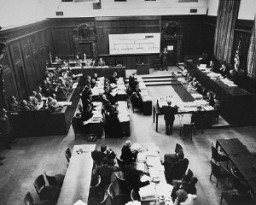
-
Ohlendorf defends himself in court
PhotoDefendant Otto Ohlendorf testifies on his own behalf at the Einsatzgruppen Trial, case #9 of the Subsequent Nuremberg Proceedings. October 9, 1947.
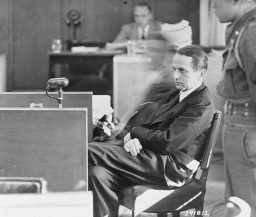
-
The "Night of Broken Glass"
ArticleOn November 9–10, 1938, the Nazi regime coordinated a wave of antisemitic violence in Nazi Germany. This became known as Kristallnacht or the "Night of Broken Glass."
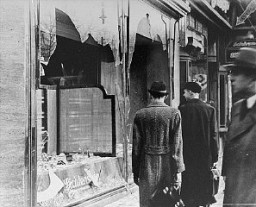
-
South Sudan Declares Independence
Timeline EventJuly 9, 2011. On this date, the Republic of South Sudan declared its independence from Sudan.
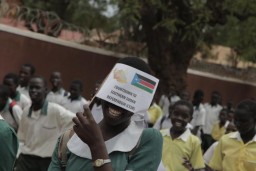
-
Theresienstadt: Key Dates
ArticleExplore key dates in the history of the Theresienstadt camp/ghetto, which served multiple purposes during its existence from 1941-45.
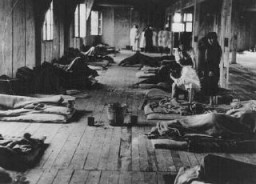
-
1945: Key Dates
ArticleExplore a timeline of key events during 1945 in the history of Nazi Germany, World War II, the Holocaust, and liberation and the aftermath of the Holocaust.
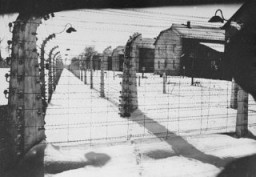
-
Destruction of the Lodz Ghetto
Timeline EventBeginning on August 9, SS and police units liquidate the Lodz ghetto.
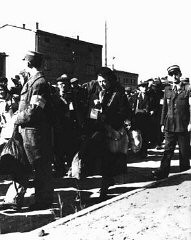
-
Vught transit camp
PhotoView of the Vught transit camp. Vught, the Netherlands, after September 9, 1944.
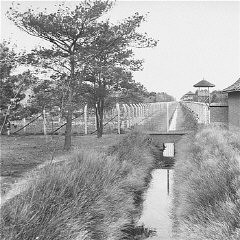
-
SS headquarters
PhotoHeadquarters of the SS chief at 9 Prince Albert Street. Berlin, Germany, date uncertain.
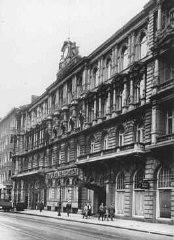
-
World War II Dates and Timeline
ArticleWorld War II was the largest and most destructive conflict in history. Learn about key WWII dates in this timeline of events, including when WW2 started and ended.
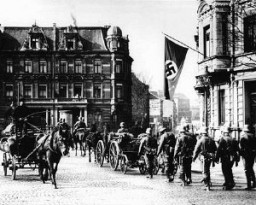
-
Kristallnacht - Photographs
Media EssayOn November 9–10, 1938, Nazi Party officials set off a series of violent pogroms against Jews in Germany and Austria. This event came to be known as the "Night of Broken Glass."

-
Alexander G. Hardy
PhotoAlexander G. Hardy, associate counsel for the prosecution, during the Doctors Trial. Nuremberg, Germany, December 9, 1946-August 20, 1947.
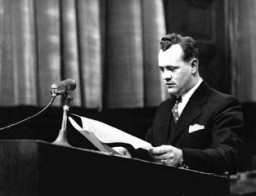
-
Dietrich Bonhoeffer
PhotoDietrich Bonhoeffer, German Protestant theologian who was executed in the Flossenbürg concentration camp on April 9, 1945. Germany, date uncertain.
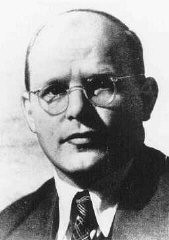
-
Blobel on trial
PhotoDefendant Paul Blobel at the Einsatzgruppen Trial, case #9 of the Subsequent Nuremberg Proceedings.
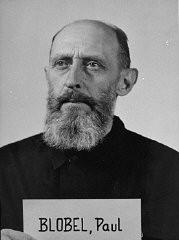
-
Burning of the synagogue in Oberramstadt
PhotoThe synagogue in Oberramstadt (a town in southwestern Germany) burns during Kristallnacht. Oberramstadt, Germany, November 9-10, 1938.
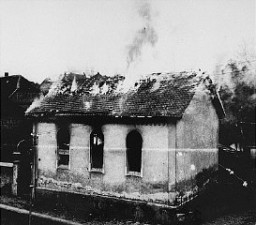
-
Beer Hall Putsch
PhotoTroops supporting Hitler arrive in Munich during the Beer Hall Putsch on November 9, 1923.
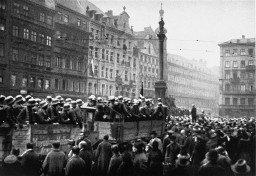
-
Housing at the Wetzlar Displaced Persons Camp
PhotoA view of the housing for Jewish displaced persons (DPs) at the Wetzlar DP camp in Germany, September 9, 1948.
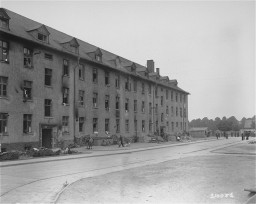
-
A Meeting at the Wetzlar DP Camp
PhotoLeaders at the Wetzlar displaced persons (DP) camp hold a meeting to discuss current happenings and improvements for the camp, September 9, 1948.
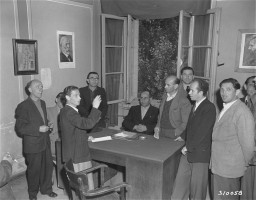
-
Kristallnacht
ArticleOn November 9–10, 1938, the Nazi regime coordinated a wave of antisemitic violence. This became known as Kristallnacht or the "Night of Broken Glass." Learn more
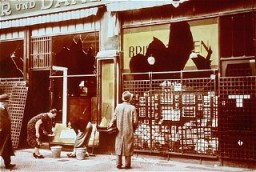
-
Fürstengrube
ArticleLearn about Fürstengrube subcamp of Auschwitz, including its establishment, administration, prisoner population, and forced labor and conditions in the camp.
-
The Holocaust and World War II: Key Dates
ArticleRead a detailed timeline of the Holocaust and World War II. Learn about key dates and events from 1933-45 as Nazi antisemitic policies became more radical.

-
1944: Key Dates
ArticleExplore a timeline of key events during 1944 in the history of Nazi Germany, World War II, and the Holocaust.
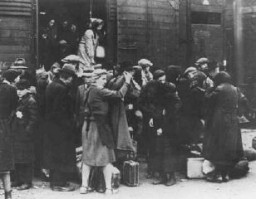
-
Death Penalty for Aiding Jews
Timeline EventSeptember 5, 1942. On this date, Germans issued this poster announcing the death penalty for anyone found aiding Jews who fled the Warsaw ghetto.
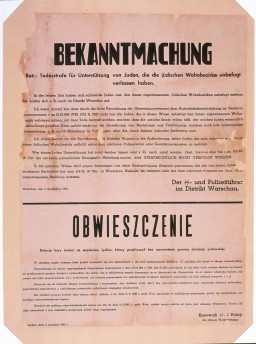
-
Heinrich Himmler: Key Dates
ArticleHeinrich Himmler was the leader of the dreaded SS of the Nazi Party from 1929 until 1945. Learn more about key dates in the life of Heinrich Himmler.
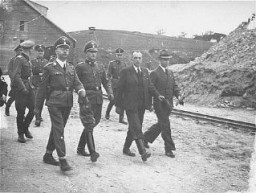
-
Deportation of Hungarian Jews
Timeline EventMay 15-July 9, 1944. On this date, Hungarian officials (under guidance from the German SS) deported some 440,000 Hungarian Jews.
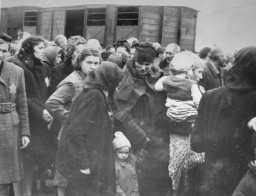
-
The "Night of Broken Glass"
Media EssayOn November 9–10, 1938, Nazi Party officials set off a series of violent pogroms against Jews in Germany and Austria. This event came to be known as the "Night of Broken Glass."
-
We Will Never Die, program cover, 1943
ArtifactThe program cover for "We Will Never Die" featured Arthur Szyk’s "Tears of Rage" artwork. The cover's original dimensions are: 12 1/16" x 9 1/16" x 3/16.
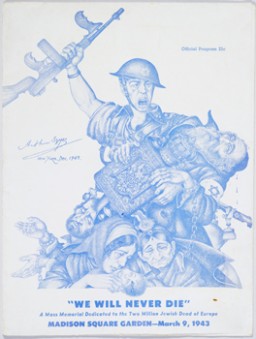
-
The prosecution team during the Doctors Trial
PhotoThe prosecution team during the Doctors' Trial. Nuremberg, Germany, December 9, 1946-August 20, 1947.
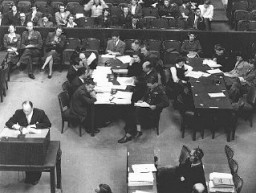
-
Prosecutor at Nuremberg
PhotoChief Prosecutor James M. McHaney during the Doctors' Trial. Nuremberg, Germany, December 9, 1946-August 20, 1947.
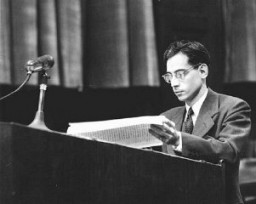
-
Construction of the United States Holocaust Memorial Museum
PhotoInstallation of the railcar at the construction site of the United States Holocaust Memorial Museum. Washington, DC, February 9, 1991.
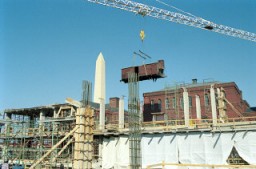
-
Antisemitic graffiti
PhotoAntisemitic graffiti on a shop window: "The Jewish parasite sold Norway on the 9th of April." April 9 was the day of the German invasion in 1940. Norway, ca. 1940.
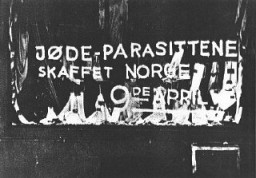
-
Hanukkah party at the Fuerth displaced persons camp
PhotoA Hanukkah party for Jewish children at the Fuerth displaced persons camp. Gifts were contributed by families of Americans stationed at the Nuremberg military post. Germany, December 9, 1947.
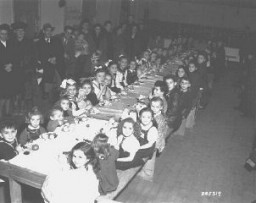
-
Soviet soldiers in a Berlin street
PhotoSoviet soldiers in a street in the Soviet occupation zone of Berlin following the defeat of Germany. Berlin, Germany, after May 9, 1945.
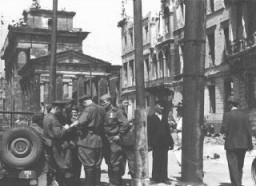
-
Soviet soldiers in the Soviet occupation zone of Berlin
PhotoSoviet soldiers in the Soviet occupation zone of Berlin following the defeat of Nazi Germany. Berlin, Germany, after May 9, 1945.

-
The Prinzregenten Street synagogue after Kristallnacht
PhotoView of the Prinzregenten Street synagogue. It was destroyed by fire during the Kristallnacht ("Night of Broken Glass") pogrom. Berlin, Germany, November 9-10, 1938.
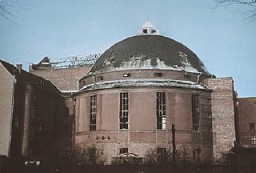
-
Burning of the ceremonial hall at the Jewish cemetery in Graz
PhotoLocal residents watch the burning of the ceremonial hall at the Jewish cemetery in Graz during Kristallnacht (the "Night of Broken Glass"). Graz, Austria, November 9–10, 1938.
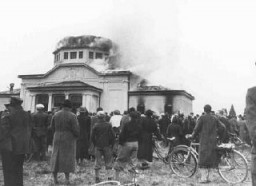
-
The Neue Weltgasse synagogue burns during Kristallnacht
PhotoThe Neue Weltgasse synagogue burns during the Kristallnacht ("Night of Broken Glass") pogrom. Vienna, Austria, November 9, 1938.
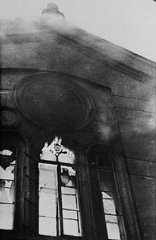
-
Desecration of the Seitenstetten Street synagogue
PhotoThe holy ark in the sanctuary of the Seitenstetten Street synagogue, demolished during Kristallnacht (the "Night of Broken Glass"). Vienna, Austria, after November 9, 1938.

-
Supplies for those interned on Cyprus
PhotoMorris Laub (right), American Jewish Joint Distribution Committee director for Cyprus, reviews supplies sent for the 12,000 Jews still interned on the island. Cyprus, December 9, 1948.
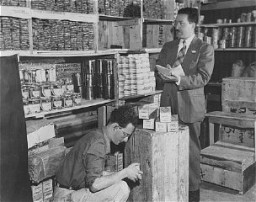
-
Some of the "Tehran Children" studying near Jerusalem.
PhotoSome of the "Tehran Children," Polish Jewish refugees, study Hebrew in a Jewish National Fund youth village near Jerusalem. Palestine, March 9, 1943.
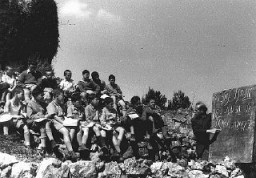
-
Peter Feigl
PhotoPhoto of Peter Feigl, a Jewish child hidden in the Protestant village Le Chambon-sur-Lignon. Le Chambon, France, August 9, 1943.
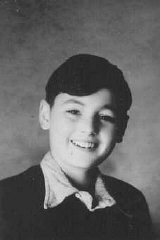
-
Photograph of Dawid Samoszul
PhotoClose-up street portrait of Dawid Samoszul, probably taken in Piotrkow Trybunalski, Poland, between 1936 and 1938. Dawid was killed in the Treblinka killing center at the age of 9.
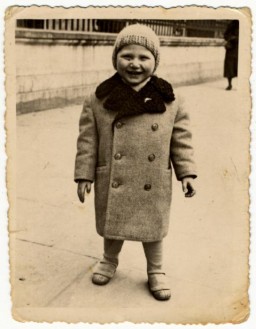
-
Chief Prosecutor Benjamin Ferencz
PhotoChief Prosecutor Benjamin Ferencz at the Einsatzgruppen Trial, Case #9 of the Subsequent Nuremberg Proceedings. Photograph taken in Nuremberg, Germany, between July 29, 1947, and April 10, 1948.
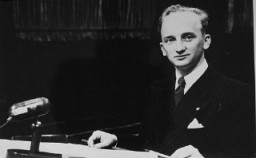
-
The defendants defense counsel during the Doctors Trial
PhotoThe defendants' dock and members of the defense counsel during the Doctors Trial. Nuremberg, Germany, December 9, 1946–August 20, 1947.
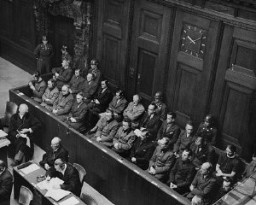
-
Brandt testifies at the Doctors' Trial
PhotoDefendant Karl Brandt testifies during the Doctors Trial. Nuremberg, Germany, December 9, 1946-August 20, 1947.
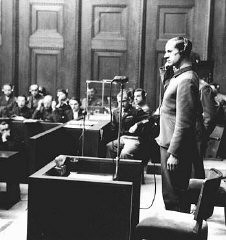
-
Brigadier General Telford Taylor
PhotoUS Chief of Counsel Brigadier General Telford Taylor during the Doctors Trial. Nuremberg, Germany, December 9, 1946-August 20, 1947.
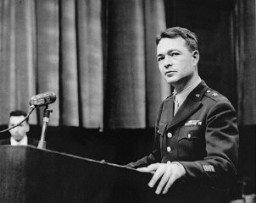
-
German soldiers hold Poles, including Polish clerics, hostage
PhotoGerman soldiers hold Poles, including Polish clerics, hostage. Bydgoszcz, Poland, September 9, 1939.
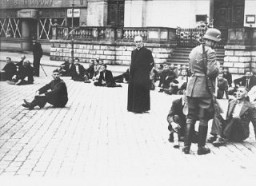
-
Chart used in the Doctors' Trial
PhotoChart used by the prosecution in the Doctors' Trial illustrates the organization of the Medical Services of the Wehrmacht (German armed forces). Nuremberg, Germany, December 9, 1946-August 20, 1947.
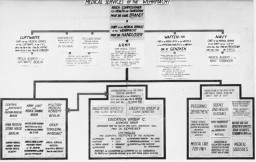
-
Demonstration in Berlin, November 1918
PhotoA public demonstration is held on the Unter den Linden in Berlin on November 9, 1918. On this day, Kaiser Wilhelm II abdicated the throne after a recent naval mutiny in Kiel inspired widespread revolution. © IWM Q 88164
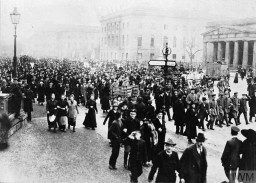
-
A group of schoolchildren in South Sudan
PhotoSchoolchildren wait in anticipation for the arrival of the US Ambassador to the United Nations and members of the UN Security Council, who have traveled to South Sudan to underscore their support for the January referendum on the region’s independence. October 9, 2010.

